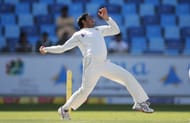Over the last few weeks, several bowlers have faced suspensions from bowling in matches on account of dodgy actions. Sometimes it has not been the whole action but a particular ball bowled that has been found doubtful. However, it is not the first instance of boards catching bowlers with suspect actions.
Committee to look at suspect actions
The BCCI set up a three-man committee to find out about how many bowlers were bowling with illegal actions at the age-group level and the results obtained are staggering.
According to an ESPN Cricinfo article, after the first IPL in 2008, 70 bowlers were found to be having illegal actions. The number increased to 135, the following year. The committee, consisting of Javagal Srinath and former umpires AV Jayaprakash and S Venkataraghavan, found that these bowlers would bowl with a different action during the rehabilitation and testing periods but operate with the suspect action while playing matches.
According to Srinath, the first step in removing this malice was to the give the umpires the responsibility of ensuring that no bowler is operating with a doubtful action.
"Umpires can get leg-befores wrong, they can get bump catches wrong, they can get caught behind wrong, but they cannot make the mistake of allowing somebody to bowl with a dodgy action and get the distinct advantage of straightening the arm,” the former Indian pace bowler said.
"When they see a bowler is suspect, they note down the ball number. It could be 10 balls, 15 balls. It could be 10.3, 11.4, the faster one, or doosra, which is absolutely bent. This is compiled. It comes to us at NCA for us to look at it," he added.
Branding someone chucker can have a psychological effect
He also added that being termed a “chucker” can have a psychological effect on the bowler’s mind and hence, on the field at least, these bowlers are given a chance.
“You don't want to call someone for chucking in open play because there is a psychological dent as well. They can definitely call him for chucking, but they give him a chance. They call him suspect,” he said.
The 45-year-old, who is a match referee now, also said that once a bowler is found to be having a suspect action, the matter is reported to the captain and if the suspect bowler bowls before undergoing rehab and is found to have a dodgy action again, then the umpire no-balls him.
"They call the captain, speak to him, tell him, if it is really bad, 'Look, stop him bowling now. We might call him for chucking. If it is getting too blatant, stop him.' Then he is called suspect, he has to go for rehabilitation and all those things. In the meantime, even before the rehab, if he comes back to play the game again, and if he is found suspect again, umpires will no-ball him.
“The point is - the teams will have to take the risk of playing him again knowing his action is suspect. In my observation, if someone is called for a suspect action, generally the team doesn't put him in the playing XI. That is the immediate reaction from the team. To not play him and let him go through the remedial process and let him come back next year or next season," he said.
Difference between NCA and scientific method
However, the procedure that is carried during the rehab at the National Cricket Academy (NCA) in Bangalore is slightly different as compared to the scientific one. At the NCA, the bowlers are made to bowl in situations that are not replicating the ones present in matches.
"We got a list of players who were suspects [after the first IPL], and this list came from first-class umpires as well as under-16, under-19 level. Umpires had found them to be suspect and that came along with the footage for us to review. This came to NCA Bangalore and the three of us saw that. At the same time these 70-odd bowlers were at the NCA undergoing rehabilitation.
“They were going through the motions and trying to get their arms straight and all those things. Everything seemed to be all right after the rehabilitation, there was no bend, there was no flex at the time of delivery. The following year, we had 135 people and many of them were the same repeat offenders from the previous years. We looked into it and saw the action has gone back to the original one," he said.
Unlike what happens in Brisbane, where bowlers are wired up and asked to bowl, the BCCI depends on the naked eye to judge the illegality of the action and the committee also does not inform the bowler with regards to the straightening of the arm.
"We had all sorts of justifications going around - A bowls like this, C bowls like this, therefore I have this action.That was wrong. So this committee of three decided that we are not going by international standards, by not taking any case examples. We said you have to go through the process. We are not calling them chuckers, we say your action requires rehabilitation, you need help. If he is really confident about it he can go to those centres, measure himself with those machines, we will definitely do the recommendation but where he goes, what he does, is up to him,” Srinath added.
Huge decrease in number of suspect actions
Impressively, the number of bowlers operating with suspect actions has come down considerably and committee feels that there is no place in the game for chuckers.
Citing a situation about the impact a bowler with dodgy action can have on a match, he said that not only will the bowler be going against the rules but when his fellow bowler who is having a fair action in the team finds out about it, it can have disheartening impact on him as well.
"What you are doing by allowing these things or even building on such ideas is, you are allowing the game to be completely contaminated.You are allowing everyone to bend their arm. 'The batsmen are ruling the roost so therefore let there be some balance.' [Instead] Give them proper wickets. Seaming wickets for fast bowlers. Maybe some turn for spinners. I think the game has to be fair. There is no way the world will accept, barring those few people who are advocating this, for the chuckers to survive.
"It would have been unfair to the players who had a good action, who had a very fair action. I would see it from the point of view of a fellow competitor who is also competing in the same tournament with a fair action. If I have a competition with another fast bowler who has been chucking left, right and centre, I will be disheartened. If I don't bowl well and don't get wickets, then it's fine. Then you are really promoting the game, you appreciate the bowler who bowls better. But if someone is chucking his way to five or six wickets every game, it is not fair. This will definitely have a cascading effect. The moment you put the guy with a dodgy action on television, kids learn cricket by watching television. The first coach is television," the Mysore Express said.
The former India pacer also said the method employed by the BCCI has been noted down by the ICC and the main aim is to keep the game as clean as possible.
"It has been discussed with the ICC. I am sure the board members, the representatives have spoken about it. There was a serious intent to crack down upon this mess, which was growing out of control. It's not about the numbers, it's about cleaning the game as quickly as possible. The question is why not then and why now. But when things are happening for the betterment of the game, then why do you ask the question why," he said.
In the recent crackdown on bowlers with suspect actions, very few names of cricketers have emerged from India. One of the reasons could be the level of monitoring that is occurring at various age-group level cricket that happens across India.
Follow IPL Auction 2025 Live Updates, News & Biddings at Sportskeeda. Get the fastest updates on Mega-Auction and cricket news

